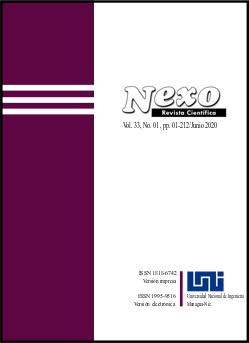Desarrollo de un proceso de salud eco amigable para el tratamiento de cicatrices patológicas excesivas
DOI:
https://doi.org/10.5377/nexo.v33i01.10054Palabras clave:
Proceso de salud ecoamigable, Queloides, Cicatrices hipertróficas, Cicatrices Inestéticas, Fotones de luz solarResumen
Un proceso de salud eco-amigable ha sido diseñado e implementado para el tratamiento de cicatrices patológicas excesivas como queloides, cicatrices hipertróficas e inestéticas mediante el uso de fotones provenientes de la luz solar como técnica alternativa no invasiva, inocua y efectiva en contraste a las técnicas convencionales actualmente empleadas que tienden a ser poco efectivas y riesgosas, que emplean insumos químicos, energía de fuentes no renovables (eléctrica) y que, muchas veces requieren de tiempos prolongados en el tratamiento. Este proceso eco amigable orientado al tema de salud está conformado por tres unidades constitutivas: la unidad de análisis, de tratamiento y de rehabilitación cutánea, que abarca desde la identificación de la patología y sus características propias (grosor, tamaño, pigmentación, etc.); hasta la prescripción del tratamiento y rehabilitación adecuada para la zona afectada. El proceso utiliza luz solar para el tratamiento y se esperan mejoras en la recuperación del tejido afectado, superándose así las limitaciones funcionales causadas, así mismo alivia el dolor y la desaparición de edemas en un 100% y, hasta un 90% de mejoría en consistencia, grosor y aspecto de la piel. El proceso puede ser aplicado a pacientes de cualquier edad, sexo y en cualquier estado de salud.
Descargas
1453
Descargas
Publicado
Cómo citar
Número
Sección
Licencia
Los autores que publican en Nexo Revista Científica están de acuerdo con los siguientes términos:
- Los autores conservan los derechos de autor y conceden a la revista el derecho de la primera publicación bajo la licencia Creative Commons Attribution License, que permite a otros compartir el trabajo con un reconocimiento a la autoría de la obra y a la publicación inicial en Nexo Revista Científica.
- Los autores pueden establecer por separado acuerdos adicionales para la distribución no exclusiva de la versión de la obra publicada en la revista (por ejemplo, en un repositorio institucional o en un libro) con el reconocimiento de su publicación inicial en Nexo Revista Científica.
- Se permite y se anima a los autores a difundir sus trabajos electrónicamente (por ejemplo, en repositorios institucionales o en su propio sitio web) antes y durante el proceso de envío, ya que puede dar lugar a intercambios productivos, así como a una citación más temprana y mayor de los trabajos publicados.










